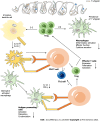Diagnosis and treatment of Whipple disease after kidney transplantation: A case report
- PMID: 37727483
- PMCID: PMC10506035
- DOI: 10.12998/wjcc.v11.i25.6019
Diagnosis and treatment of Whipple disease after kidney transplantation: A case report
Abstract
Background: Kidney transplantation is the standard treatment for end-stage renal disease. Particularly, rare and specific pathogenic infections which are asymptomatic are often difficult to diagnose, causing delayed and ineffective treatment and thus seriously affecting prognosis. Tropheryma whipplei (T. whipplei) is a Gram-positive actinomycete widely found in soil, sewage, and other external environments and is present in the population as an asymptomatic pathogen. There is relatively little documented research on T. whipplei in renal transplant patients, and there are no uniform criteria for treating this group of post-transplant patients. This article describes the treatment of a 42-year-old individual with post-transplant T. whipplei infection following kidney transplantation.
Case summary: To analyze clinical features of Whipple's disease and summarize its diagnosis and treatment effects after renal transplantation. Clinical data of a Whipple's disease patient treated in the affiliated hospital of Guizhou Medical University were collected and assessed retrospectively. The treatment outcomes and clinical experience were then summarized via literature review. The patient was admitted to the hospital due to recurrent diarrhea for 1 mo, shortness of breath, and 1 wk of fever, after 3 years of renal transplantation. The symptoms of the digestive and respiratory systems were not significantly improved after adjusting immunosuppressive regimen and anti-diarrheal, empirical antibiotic treatments. Bronchoscopic alveolar fluid was collected for meta-genomic next-generation sequencing (mNGS). The deoxyribonucleic acid sequence of Tropheryma whipplei was detected, and Whipple's disease was diagnosed. Meropenem, ceftriaxone, and other symptomatic treatments were given, and water-electrolyte balance was maintained. Symptoms resolved quickly, and the patient was discharged after 20 d of hospitalization. The compound sulfamethoxazole tablet was continued for 3 mo after discharge. No diarrhea, fever, and other symptoms occurred during the 6-month follow-up.
Conclusion: Whipple's disease is rare, with no specific symptoms, which makes diagnosis difficult. Polymerase chain reaction or mNGS should be immediately performed when the disease is suspected to confirm the diagnosis.
Keywords: Case report; Immunosuppression; Kidney transplantation; Macrogenomics second-generation sequencing technology; Whipple disease; Whipple’s nutrient barrier.
©The Author(s) 2023. Published by Baishideng Publishing Group Inc. All rights reserved.
Conflict of interest statement
Conflict-of-interest statement: All authors declare that there is no conflict of interest in this study.
Figures
Similar articles
-
Whipple's disease of the respiratory system: A case report.Exp Ther Med. 2024 Feb 7;27(4):133. doi: 10.3892/etm.2024.12421. eCollection 2024 Apr. Exp Ther Med. 2024. PMID: 38414785 Free PMC article.
-
Use of polymerase chain reaction in the diagnosis of Whipple's disease.J Infect Chemother. 2015 Dec;21(12):885-8. doi: 10.1016/j.jiac.2015.08.010. Epub 2015 Sep 19. J Infect Chemother. 2015. PMID: 26390825
-
Whipple's disease presenting as weight gain and constipation in a Chinese woman.BMC Infect Dis. 2023 May 8;23(1):302. doi: 10.1186/s12879-023-08276-y. BMC Infect Dis. 2023. PMID: 37158848 Free PMC article.
-
[Whipple's disease and Tropheryma whipplei infections in internal medicine. When to think about it? How to treat?].Rev Med Interne. 2014 Dec;35(12):801-7. doi: 10.1016/j.revmed.2014.04.016. Epub 2014 Jun 2. Rev Med Interne. 2014. PMID: 24933290 Review. French.
-
Chorioretinitis and vitreitis due to Tropheryma whipplei after transplantation: case report and review.Transpl Infect Dis. 2008 Dec;10(6):413-8. doi: 10.1111/j.1399-3062.2008.00322.x. Epub 2008 Jun 18. Transpl Infect Dis. 2008. PMID: 18564981 Review.
Cited by
-
Whipple's disease of the respiratory system: A case report.Exp Ther Med. 2024 Feb 7;27(4):133. doi: 10.3892/etm.2024.12421. eCollection 2024 Apr. Exp Ther Med. 2024. PMID: 38414785 Free PMC article.
References
-
- Chitty DW, Hartley-Brown MA, Abate M, Thakur R, Wanchoo R, Jhaveri KD, Nair V. Kidney transplantation in patients with multiple myeloma: narrative analysis and review of the last two decades. Nephrol Dial Transplant. 2022;37:1616–1626. - PubMed
-
- Mason P, Robb ML. Improving Access to Renal Transplantation for Highly Sensitized Patients. Transplantation. 2022;106:2299–2300. - PubMed
-
- Slagter JS, Outmani L, Tran KTCK, Ijzermans JNM, Minnee RC. Robot-assisted kidney transplantation as a minimally invasive approach for kidney transplant recipients: A systematic review and meta-analyses. Int J Surg. 2022;99:106264. - PubMed
Publication types
LinkOut - more resources
Full Text Sources


